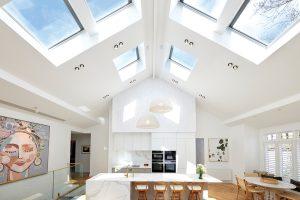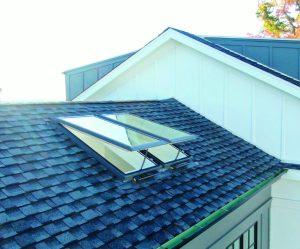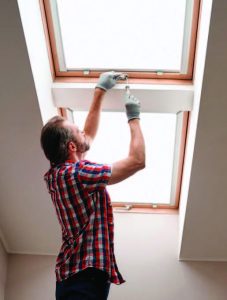 Bright and cheerful spaces are often sought after by homeowners. Walking into such a space can boost your mood almost instantly. One of the most common ways to achieve a bright and well-lit space is to install a skylight. While having a skylight in your home is not necessarily all sunshine and rainbows, you will certainly reap the benefits with proper installation and maintenance if you decide to install one in your home. Here are several things you should know before you decide to have a skylight installed.
Bright and cheerful spaces are often sought after by homeowners. Walking into such a space can boost your mood almost instantly. One of the most common ways to achieve a bright and well-lit space is to install a skylight. While having a skylight in your home is not necessarily all sunshine and rainbows, you will certainly reap the benefits with proper installation and maintenance if you decide to install one in your home. Here are several things you should know before you decide to have a skylight installed.
Brightness
By installing a skylight, you will transform the feeling of your room. From a design standpoint, skylights can add a spotlight effect to rooms that you would like to emphasize or highlight. Skylights also allow you to use less electricity to light your space. The natural, more direct light is especially beneficial in the colder months when the days are shorter. Sunlight will shine through more directly than it would through a window, allowing your room to be brighter for longer. Plus, extra natural light can be helpful during power outages brought on by Florida’s storms. Overall, by installing a skylight, you are creating a more natural and appealing lighting concept in your home and reducing your energy consumption.
Fresh Air
 With a skylight that opens up, you will be improving the ventilation of your home and bringing in more fresh air. The ventilation that skylights provide is especially useful in rooms where moisture accumulates, such as the bathroom. Skylights that can open and close help prevent moisture buildup. This eliminates excess condensation and even aids in maintaining the structural integrity of the skylight. Because heat rises, skylights that can open and close will actually fix issues with overheating. Simply open the skylight and the heat will exit through it.
With a skylight that opens up, you will be improving the ventilation of your home and bringing in more fresh air. The ventilation that skylights provide is especially useful in rooms where moisture accumulates, such as the bathroom. Skylights that can open and close help prevent moisture buildup. This eliminates excess condensation and even aids in maintaining the structural integrity of the skylight. Because heat rises, skylights that can open and close will actually fix issues with overheating. Simply open the skylight and the heat will exit through it.
Temperature Control
Where there is brightness, there is heat. Greenhouses get hot due to light coming through the glass. Heat is trapped inside with no way to get out. Skylights are not all that different. A major issue with skylights is overheating. The rooms in your home with skylights may feel warmer than those without, which could require you to crank up the AC. The sun that shines through may also bleach any exposed wood or paint over time. There are two key ways to avoid overheating and bleaching, the first being to install a skylight with gray or bronze-tinted glass or applying a window film over it. This will prevent excess heat and harmful UV rays from coming through. Another useful tip for the installation process would be to place the skylight north-facing rather than south-facing. This will allow for indirect sunlight to shine through. Indirect sunlight is less harsh and will cause fewer issues.
On the other hand, in the winter months, skylights can make your space colder due to the lack of insulation. The glass allows for colder temperatures to infiltrate the home. Similarly, metal is a conductor of heat in the hotter months and is subject to heat loss in the colder months. Many deliberately avoid this by installing thermally broken skylights, which provide some insulation in the frame of the skylight.
Leaking
 The most common issue that you should be aware of is leakage. Skylights are known to leak and develop moisture issues. These issues are typically due to incorrect installation but can develop due to wear and age as well. Furthermore, skylights often face problems with the sealant, which is how water is able to get through. The leak will present itself in the home and potentially the roof as well, which can lead to severe damage and necessary repairs. You should not have to fear rain in your own home. For this reason, it is vital to hire a skilled contractor with a great deal of experience with skylight installation. An experienced roofing contractor can install a skylight that can last up to twenty years. Inexperienced roofing contractors may install a skylight that leaks the first time it rains after installation. There are ways to reseal it on your own, such as using roofing cement or replacing the metal flashing around the frame, but a skilled contractor will better understand where the leak is coming from and how to repair it.
The most common issue that you should be aware of is leakage. Skylights are known to leak and develop moisture issues. These issues are typically due to incorrect installation but can develop due to wear and age as well. Furthermore, skylights often face problems with the sealant, which is how water is able to get through. The leak will present itself in the home and potentially the roof as well, which can lead to severe damage and necessary repairs. You should not have to fear rain in your own home. For this reason, it is vital to hire a skilled contractor with a great deal of experience with skylight installation. An experienced roofing contractor can install a skylight that can last up to twenty years. Inexperienced roofing contractors may install a skylight that leaks the first time it rains after installation. There are ways to reseal it on your own, such as using roofing cement or replacing the metal flashing around the frame, but a skilled contractor will better understand where the leak is coming from and how to repair it.
Maintenance
 Once you have installed a skylight, you need to monitor it and complete any necessary maintenance. Firstly, be on the lookout for any leaks. As previously stated, if you hire a skilled contractor, leaks are far less likely to occur. Even so, it is better to be aware if there are any issues considering how detrimental leaks can be and that they can appear over time due to natural wear. Leaks can create puddles in your home and can even cause mold to grow on your roof or elsewhere. Of course, this can cost lots of money to repair, so you should have your skylight inspected annually just to ensure that no issues are present. An inspector will be able to detect things that the average person cannot and help prevent damage that you are unaware of from getting worse. Lastly, skylights should be cleaned once or twice each year to ensure that light is shining through to the fullest extent. This can be dangerous, though, so it may be best to hire a trained professional for this task depending on the placement of the skylight.
Once you have installed a skylight, you need to monitor it and complete any necessary maintenance. Firstly, be on the lookout for any leaks. As previously stated, if you hire a skilled contractor, leaks are far less likely to occur. Even so, it is better to be aware if there are any issues considering how detrimental leaks can be and that they can appear over time due to natural wear. Leaks can create puddles in your home and can even cause mold to grow on your roof or elsewhere. Of course, this can cost lots of money to repair, so you should have your skylight inspected annually just to ensure that no issues are present. An inspector will be able to detect things that the average person cannot and help prevent damage that you are unaware of from getting worse. Lastly, skylights should be cleaned once or twice each year to ensure that light is shining through to the fullest extent. This can be dangerous, though, so it may be best to hire a trained professional for this task depending on the placement of the skylight.
Skylights can provide beautiful lighting and even ventilate your home, but they can also have issues with temperature and leak. Do not let this discourage you from installing one though. The cons are not as significant as they may seem as long as a skilled contractor completes the job, and even if issues do present themselves, they can be fixed! With monitoring and occasional cleaning, skylights are a wonderful addition to your home! ![]()
Emily Schutz
Home & Yard Magazine




